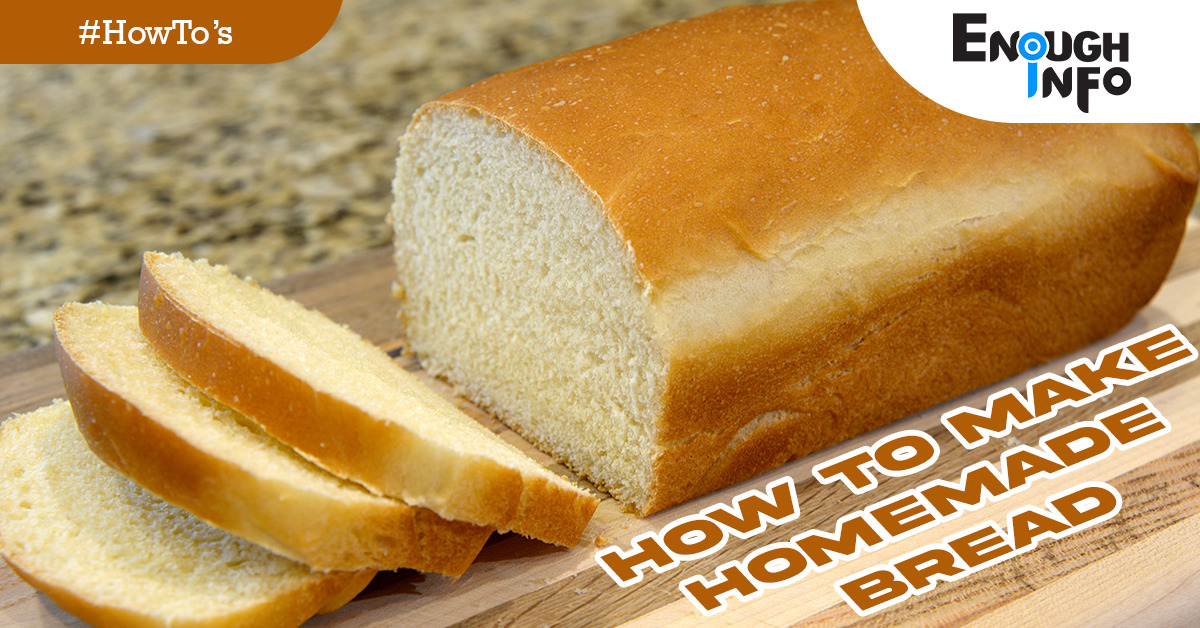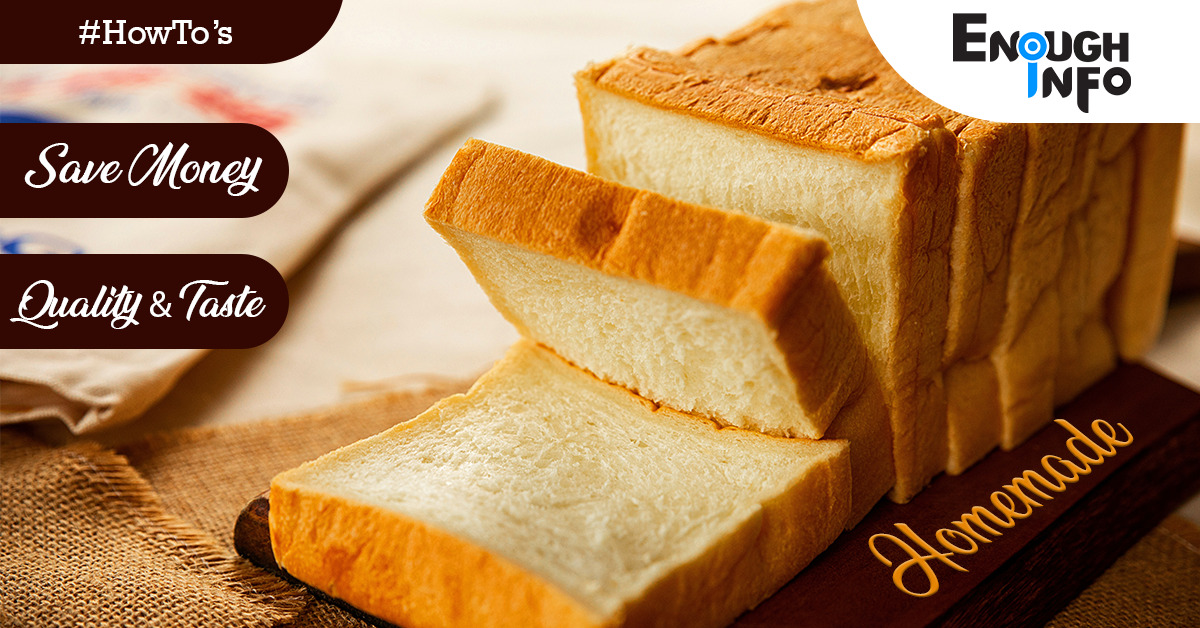How To Make Homemade Bread(Step By Step)

How To Make Homemade Bread: There’s something truly magical about the aroma of freshly baked bread wafting through your home. Making homemade bread is not only a culinary delight but also a therapeutic and rewarding experience. EnoughInfo.com

Making homemade bread is important because it allows you to prioritize your health, enjoy superior taste and quality, save money, bond with loved ones, express creativity, and experience the therapeutic nature of baking. It empowers you to be self-sufficient, embrace sustainable living, and find joy in the process of creating something nourishing and delicious. So, grab your apron and embark on the journey of making homemade bread – you won’t be disappointed! How To Create a DIY Skincare Routine
Read Also: How To Make Homemade Pizza Dough
FAQs & Answers on How To Make Homemade Bread
What is the best flour for homemade bread?
For a classic bread recipe, all-purpose flour or bread flour works well. Whole wheat flour and specialty flours like rye or spelt can be used for variations. Experiment with different flours to find the flavors and textures you prefer.
How can I achieve a lighter, airier texture in my bread?
To achieve a lighter texture, ensure your yeast is fresh and active, knead the dough thoroughly to develop gluten, and allow proper rising time. Avoid adding too much flour, as it can make the dough dense. Gentle handling and patience are key.
Can I make bread without yeast?
Yes, there are yeast-free bread options like soda bread or quick breads that utilize baking soda or baking powder as leavening agents. These types of bread have a different texture and flavor profile but can be equally delicious.
How long does the bread-making process take?
The bread-making process typically takes a few hours, including proofing, kneading, rising, and baking. The exact time can vary based on the recipe, rising conditions, and desired flavors. Sourdough bread, for example, requires longer fermentation periods.
How can I tell if my bread is fully baked?
A fully baked bread will have a golden-brown crust, sound hollow when tapped on the bottom, and have an internal temperature of around 190-200°F (88-93°C). Use a food thermometer to ensure it’s cooked through without being overdone.
Read Also: How To Bake Chocolate Chip Cookies
Making homemade bread is important for several reasons:

1. Health and Nutrition
Homemade bread allows you to have control over the ingredients used, ensuring that you’re consuming wholesome and nutritious bread. You can choose high-quality flours, include whole grains, and avoid additives, preservatives, and excessive sodium or sugar often found in store-bought bread. How to Clean Stainless Steel Appliances
2. Taste and Flavor
Homemade bread offers a superior taste and flavor compared to mass-produced alternatives. The fresh ingredients and the care put into the baking process result in a loaf that is incredibly flavorful, aromatic, and satisfying. You can also customize the flavors by adding herbs, spices, or other ingredients of your choice.
3. Quality and Freshness
When you make bread at home, you can enjoy it at its freshest. Warm, crusty loaves straight from the oven are a pure delight. By baking your own bread, you can avoid the staleness that sometimes comes with store-bought bread and ensure that you’re consuming a high-quality product. How To Make A DIY Gift For A Friend
4. Cost Savings
While there may be an initial investment in ingredients and equipment, making bread at home can save you money in the long run. The cost of store-bought bread adds up over time, especially if you prefer artisanal or specialty varieties. Homemade bread allows you to produce multiple loaves at a fraction of the cost.
5. Bonding and Creativity
Baking bread at home can be a wonderful shared activity for families, friends, or couples. It provides an opportunity to bond, work together in the kitchen, and create something delicious. It also allows you to unleash your creativity by experimenting with different recipes, flavors, and techniques. How To Play The Piano Without Reading Sheet Music
6. Self-Sufficiency and Independence
Being able to make your own bread empowers you to be self-sufficient in a basic skill. It’s a valuable skill to possess, especially during times when access to store-bought bread may be limited. It offers a sense of independence and the satisfaction of providing for yourself and your loved ones.
Read Also: How to make homemade ice cream without an ice cream maker
7. Mindful and Therapeutic Experience
Baking bread can be a mindful and therapeutic experience. The process of kneading dough, watching it rise, and smelling the aroma as it bakes can be relaxing and satisfying. It allows you to slow down, be present in the moment, and find joy in the simple act of creating.
8. Sustainable Living
Making homemade bread aligns with a sustainable lifestyle. By baking your own bread, you can reduce packaging waste associated with store-bought bread. You also have the flexibility to choose organic and locally sourced ingredients, supporting sustainable agricultural practices. How To Clean Hardwood Floors Naturally
In this comprehensive guide, we will delve into the art of making homemade bread, exploring various techniques, recipes, and tips to help you master the craft. From choosing the right ingredients to perfecting the kneading and baking process, we’ve got you covered.
Getting Started with Homemade Bread
The Benefits of Baking Your Own Bread: Baking bread at home offers numerous advantages, including the ability to control ingredients, customize flavors, save money, and experience the joy of creating something from scratch. Additionally, homemade bread is free from preservatives and additives commonly found in store-bought alternatives.
Essential Tools and Ingredients: To embark on your bread-making journey, you’ll need basic tools such as mixing bowls, measuring cups, a sturdy mixing spoon, and a baking pan or loaf tin. Key ingredients include flour, yeast, water, salt, and optionally, sweeteners or fats. How Much To Tip On A Cruise (7 Cruise Tipping Guidelines)
Understanding the Basic Bread-Making Process: Familiarize yourself with the fundamental steps of bread-making, including proofing the yeast, kneading the dough, the first and second rise, shaping the loaf, and baking. Each stage plays a crucial role in developing the flavor, texture, and structure of the bread.
Bread-Making Techniques

Classic White Bread: Learn the art of making a classic white bread loaf, perfect for sandwiches or toast. From mixing the ingredients to kneading the dough and achieving a light, fluffy texture, we’ll guide you through each step of the process.
Whole Wheat and Multigrain Varieties: Explore the world of whole wheat and multigrain bread, which offer added nutritional value and a nutty, hearty flavor. Discover the proper techniques to incorporate different grains and achieve a well-balanced loaf.
Sourdough Bread: From Starter to Loaf: Sourdough bread is known for its distinct tangy flavor and chewy texture. Master the process of creating and maintaining a sourdough starter, as well as the steps involved in baking a sourdough loaf to perfection.
Artisanal and Specialty Breads: Delve into the realm of artisanal and specialty breads. Expand your bread-making repertoire by exploring unique and flavorful options such as focaccia, baguettes, ciabatta, and more. Learn techniques like shaping, scoring, and incorporating herbs, spices, and other ingredients to create artisanal masterpieces.
Troubleshooting and Tips
Common Bread-Making Challenges and Solutions:
Encounter common issues like dense loaves, uneven rise, or burnt crust? We’ll provide troubleshooting tips to help you overcome these challenges and achieve consistent, high-quality results with your homemade bread.
Enhancing Flavor and Texture:
Discover techniques for enhancing the flavor and texture of your bread. From incorporating herbs, spices, and cheeses to experimenting with different types of flour, hydration levels, and fermentation times, we’ll show you how to take your bread to the next level.
Read Also: How To Make French Toast(Step by Step)
Storing and Preserving Homemade Bread:
Learn the best practices for storing and preserving your homemade bread to keep it fresh and delicious for longer. From proper wrapping and freezing techniques to reviving stale bread, we’ll ensure your efforts don’t go to waste.
Experimenting with Additions and Variations:
Feel free to unleash your creativity and experiment with various additions and variations to create unique bread flavors. From adding nuts, seeds, or dried fruits to incorporating different flours or creating swirls of fillings, the possibilities are endless.
Fresh baked bread with homemade strawberry, raspberry, or peach jam is our favourite way to consume it. It’s simply divine. There are so many things I adore about this bread recipe, but one of my favourites is that it just requires shelf stable ingredients (no milk, eggs, or butter!) AND IT’S SIMPLE AND EASY TO MAKE! You can’t go wrong with this, whether you’re a novice or a seasoned bread maker, and I know you’ll enjoy it!
Ingredients required:
- Warm water (105-115 degrees) is required to activate the yeast.
- Active Dry yeast: Instant or rapid rise yeast can be replaced if my adaptation suggestions in the recipe card are followed.
- Granulated sugar or honey: the sugar is used to “feed” the yeast and make the bread more soft.
- To increase flavour, add salt.
- Vegetable or canola oil, or melted butter, could be substituted for the oil.
- Bread flour or all-purpose flour can be used interchangeably in this recipe. The precise amount of flour required will vary based on several circumstances (altitude/humidity, for example). The texture of the dough is important. It should be smooth and pull away from the bowl’s sides. If you add too much flour, your bread will become dense. When touched with a clean finger, the dough should be somewhat sticky.
Fresh yeast is recommended!
- The bread will not rise correctly if your yeast is outdated or faulty. We’ll put it to the test in the first step of the recipe. To ensure the highest quality, keep yeast in the refrigerator.
- To reduce the time it takes for the bread to rise: Make the dough up to the first rising, then place it in a well-greased basin, flipping it once to grease it all over. Wrap the bowl in plastic wrap. Preheat the oven to 180°F, then turn it off. Place the bowl in the oven, leaving the oven door slightly ajar. Allow to double in size. Then take them out, punch them down, and shape them into loaves.
Read Also: How To Make A Homemade Pizza From Scratch
Conclusion
Making homemade bread is an art that brings immense joy, satisfaction, and a delightful aroma to your kitchen. With this comprehensive guide, you now have the knowledge and techniques to embark on your bread-making journey. Whether you prefer classic loaves, whole wheat varieties, sourdough bread, or artisanal creations, the possibilities are endless.
Remember to start with the basics, experiment, and learn from each baking experience. Troubleshoot challenges, enhance flavors and textures, and explore different techniques and variations. With practice, patience, and a passion for baking, you’ll soon be producing delicious homemade bread that will impress your family and friends.
So, roll up your sleeves, gather your ingredients, and let the journey of homemade bread-making begin! Enjoy the process, the aroma, and the satisfaction of creating something truly special from scratch. Embrace the art of homemade bread and savor every delicious slice.
Happy baking!
Recommended;
How To Make Cold Brew Coffee (Step by step)
How To Cook Scrambled Eggs (Step By Step)
30 Hobbies That Make You Money




